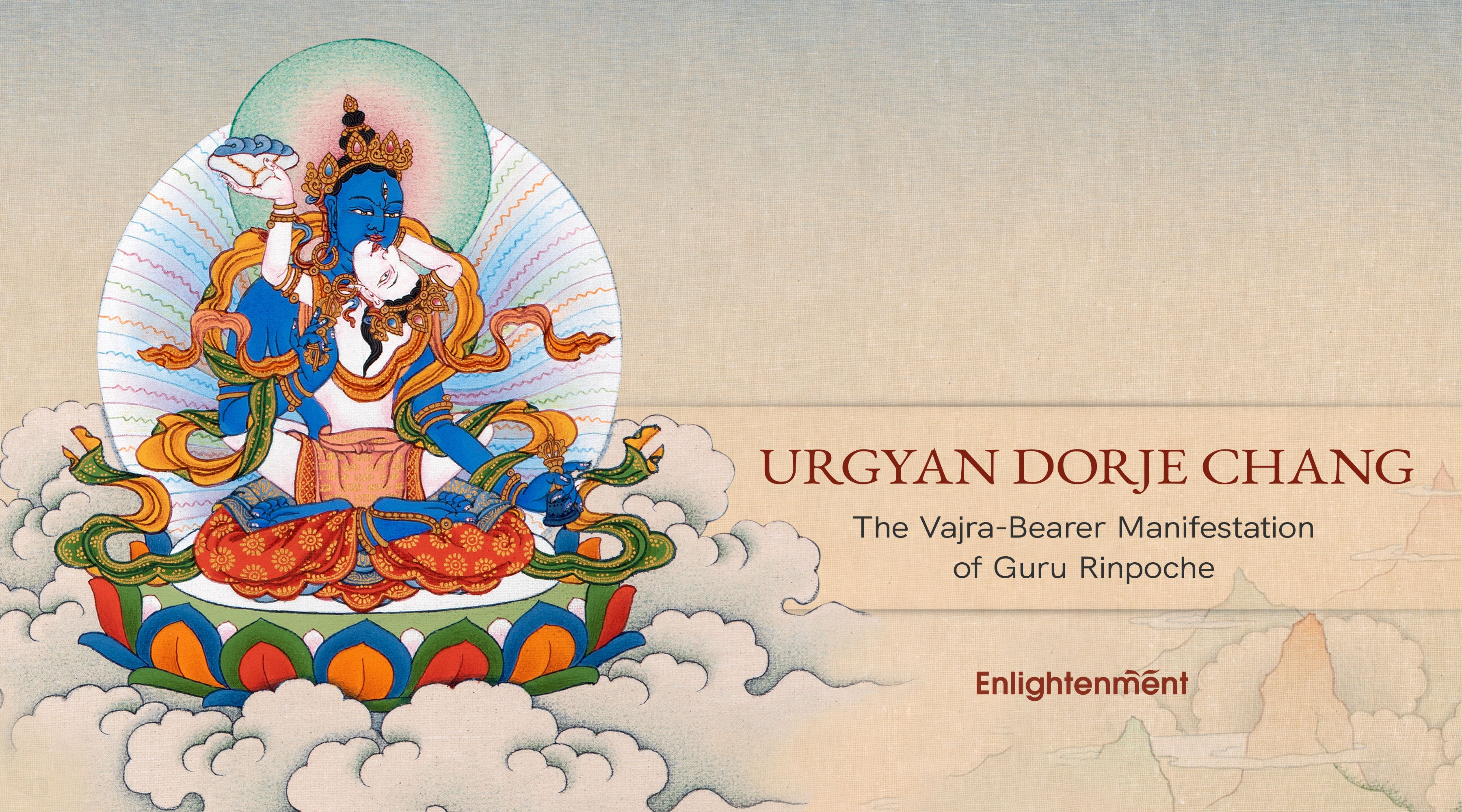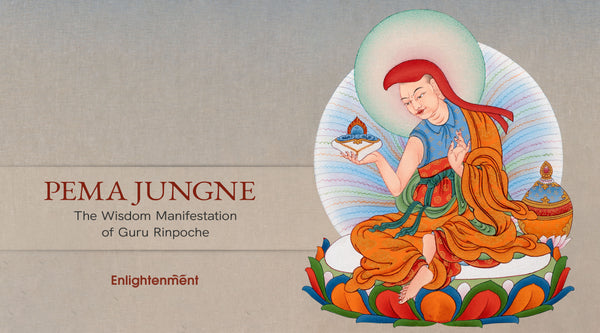Urgyan Dorje Chang is the Supreme Embodiment of Guru Rinpoche
Guru Urgyan Dorje Chang is revered in the vast pantheon of Vajrayana Buddhism as a manifestation of Guru Rinpoche. Also known as Guru Padmasambhava, he is the ultimate symbol of enlightenment and his teachings are seen as a means to attain enlightenment and liberation from suffering. In his eight forms of manifestations, he became exceptionally active in the propagation of the Dharma.
The form of Urgyan Dorje is worshipped as a tantric deity, and he represents the enlightened mind in its most primordial and pure state. Hence, he holds a unique position in the spiritual lineage of Tibetan Buddhism, embodying not only the wisdom of Guru Rinpoche but also the ultimate expression of Vajradhara, the primordial Buddha. This manifestation holds immense significance for practitioners seeking the highest levels of enlightenment, especially within the Nyingma and Kagyu schools.
In addition to Dorje Chang, the other divine and pious forms taken by the revered Guru Rinpoche are mentioned below:
- Shakya Senge
- Pema Gyalpo
- Nyima Odzer
- Dorje Drolo
- Senge Dradog
- Lodan Chokse
- Pema Jungne
- Urgyan Dorje Chang

Origins and Significance of Urgyan Dorje Chang
It is believed that Orgyen Dorje Chang was a yogi and spiritual teacher. And when he received the Mahayoga teachings from the Adi Buddhas in Akanishta Heaven, he became known as Guru Urgyan Dorje Chang, a manifestation of Guru Rinpoche to fulfill the specific purpose of restoring and promulgating Dharma.
He is an expression of the highest enlightened state, often considered to be the ultimate nature of mind—free from all conceptualization. In Tibetan Buddhism, each of the three names holds a significant meaning:
- Urgyen: This refers to the sacred and mythical land of Urgyen in Uddiyana. It is traditionally believed to be the birthplace of Guru Rinpoche and the origin place of tantric Buddhism.
- Dorje: It means "vajra" in Sanskrit, a symbolic weapon representing both the indestructible nature of reality and the method aspect of wisdom.
- Chang: It is translated as "holder" or "bearer." Hence, he is also known as Vajradhara, the primordial Buddha who embodies the absolute and unchanging truth of the dharma.
Guru Urgyan emerges as the union of these two powerful figures, representing the inseparability of the Guru principle (Guru Rinpoche) and the primordial state of enlightenment (Vajradhara). This union is seen as the ultimate guide for Vajrayana practitioners, especially in Dzogchen and Mahamudra, which aim to realize the mind’s inherent purity and luminosity.
Meanwhile, Orgyen Dorje Chang's divine appearance signifies the embodiment of the three kayas—the three bodies of Buddha:
- Dharmakaya: The truth body, representing the formless aspect of Buddha’s nature.
- Sambhogakaya: The enjoyment body, which appears to bodhisattvas in pure lands.
- Nirmanakaya: The emanation body, manifesting in the physical world to teach sentient beings.
This trifold nature makes him a prominent symbol of realization who guides practitioners towards the realization of these three aspects within themselves.
Iconography and Symbolism of Urgyan Dorje Chang
The iconography of Urgyan Dorje Chang is deeply symbolic and full of meanings. He is often depicted sitting in the vajra posture on a lotus throne, radiating an aura of calmness, wisdom, and immeasurable compassion. His body is typically blue, representing the vast expanse of emptiness and the unchanging nature of the dharma.

Key elements of Urgyan Dorje Chang's Iconography:
- Vajra: He holds a vajra in his right hand, symbolizing indestructibility and the ultimate truth of emptiness.
- Bell (Ghanta): Dorje Chang holds a bell in his left hand, which represents wisdom and the feminine principle. Together, the vajra and bell symbolize the union of wisdom and compassion, a core principle in Vajrayana practice.
- Crown of Five Skulls: He wears a crown of five skulls that represent the transformation of the five poisons: ignorance, attachment, aversion, pride, and jealousy into the five wisdoms of the Buddha.
- Lotus Throne: His seat is a lotus throne, which signifies his purity and freedom from samsaric existence.
- Union with Yeshe Tsogyal: They are often depicted together as a divine couple, symbolizing the union of wisdom and compassion. His consort, Yeshe Tsogyal, is renowned for her wisdom and spiritual accomplishments. She is considered a powerful and enlightened yogini in Vajrayana.
The art of Urgyan Dorje is not just an artistic representation but a guide to meditation. The majority of practitioners visualize his body, speech, and mind as a means to transcend dualistic thinking and realize the inseparable nature of samsara and nirvana.
Urgyan Dorje Chang in Contemporary Vajrayana Practice
In today’s Vajrayana practice, Urgyan Dorje Chang holds a central role for advanced practitioners. As mentioned above, he is prominent in the Dzogchen and Mahamudra meditations. Many lineages emphasize the importance of recognizing the intrinsic nature of the mind, and Orgyen Dorje Chang acts as a reminder of this goal. His practice is particularly relevant for those seeking direct realization of the mind's true nature without conceptual elaboration.
The influence of Dorje Chang extends beyond formal meditation settings. He represents the aspiration for the highest level of enlightenment, where all dualistic concepts dissolve, and the practitioner directly experiences the nature of reality as it is. This aspiration informs the daily lives of Vajrayana practitioners, reminding them of their innate potential for Buddhahood.
Moreover, teachings connected to him are often passed down in oral lineages (terma) by accomplished Tibetan lamas. This has ensured his importance as a profound deity, and this practice has continued to guide devotees towards the realization of the Great Perfection.
Urgyan Dorje Chang: A Powerful Bridge of Tantra and Dharma
Urgyan Dorje Chang represents the pinnacle of realization in Vajrayana Buddhism as one of the eight manifestations of Guru Rinpoche. His presence within the lineage of teachings inspires practitioners to move beyond dualistic thinking and realize the true nature of the mind. He plays a vital role in the spiritual lives of many Vajrayana Buddhists today through his iconography, practices, and contemporary relevance,
In a world where distractions abound , and the path to enlightenment can seem obscure, the image and practice of Orgyen Dorje Chang serve as a clear reminder that the highest realization is always within reach. But only if one is willing to look within and recognize the mind's inherent purity.


